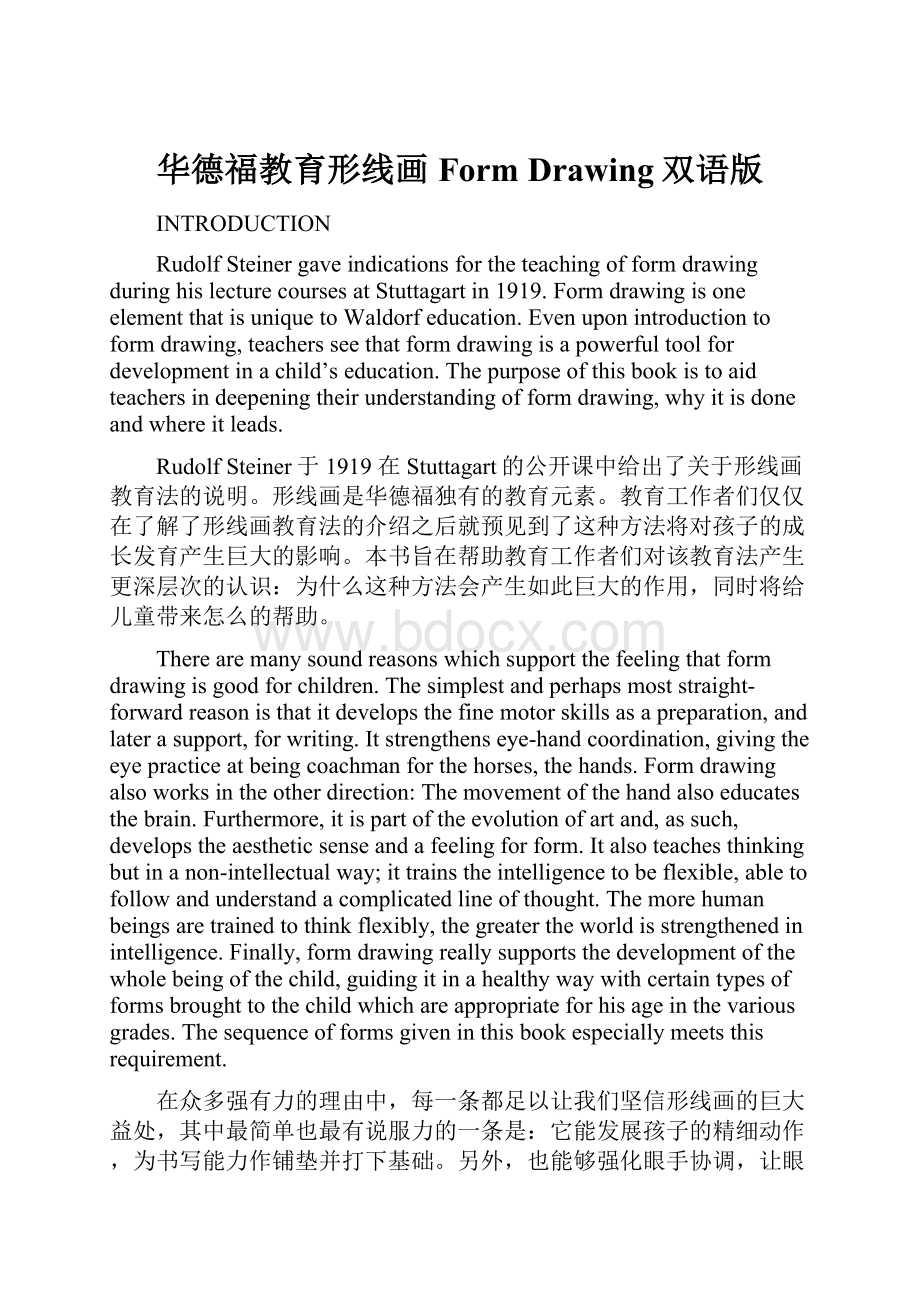华德福教育形线画Form Drawing双语版.docx
《华德福教育形线画Form Drawing双语版.docx》由会员分享,可在线阅读,更多相关《华德福教育形线画Form Drawing双语版.docx(25页珍藏版)》请在冰豆网上搜索。

华德福教育形线画FormDrawing双语版
INTRODUCTION
RudolfSteinergaveindicationsfortheteachingofformdrawingduringhislecturecoursesatStuttagartin1919.FormdrawingisoneelementthatisuniquetoWaldorfeducation.Evenuponintroductiontoformdrawing,teachersseethatformdrawingisapowerfultoolfordevelopmentinachild’seducation.Thepurposeofthisbookistoaidteachersindeepeningtheirunderstandingofformdrawing,whyitisdoneandwhereitleads.
RudolfSteiner于1919在Stuttagart的公开课中给出了关于形线画教育法的说明。
形线画是华德福独有的教育元素。
教育工作者们仅仅在了解了形线画教育法的介绍之后就预见到了这种方法将对孩子的成长发育产生巨大的影响。
本书旨在帮助教育工作者们对该教育法产生更深层次的认识:
为什么这种方法会产生如此巨大的作用,同时将给儿童带来怎么的帮助。
Therearemanysoundreasonswhichsupportthefeelingthatformdrawingisgoodforchildren.Thesimplestandperhapsmoststraight-forwardreasonisthatitdevelopsthefinemotorskillsasapreparation,andlaterasupport,forwriting.Itstrengthenseye-handcoordination,givingtheeyepracticeatbeingcoachmanforthehorses,thehands.Formdrawingalsoworksintheotherdirection:
Themovementofthehandalsoeducatesthebrain.Furthermore,itispartoftheevolutionofartand,assuch,developstheaestheticsenseandafeelingforform.Italsoteachesthinkingbutinanon-intellectualway;ittrainstheintelligencetobeflexible,abletofollowandunderstandacomplicatedlineofthought.Themorehumanbeingsaretrainedtothinkflexibly,thegreatertheworldisstrengthenedinintelligence.Finally,formdrawingreallysupportsthedevelopmentofthewholebeingofthechild,guidingitinahealthywaywithcertaintypesofformsbroughttothechildwhichareappropriateforhisageinthevariousgrades.Thesequenceofformsgiveninthisbookespeciallymeetsthisrequirement.
在众多强有力的理由中,每一条都足以让我们坚信形线画的巨大益处,其中最简单也最有说服力的一条是:
它能发展孩子的精细动作,为书写能力作铺垫并打下基础。
另外,也能够强化眼手协调,让眼睛成为指导双手动作的教练,而手部精细动作的锻炼也能增长智力。
与此同时,作为艺术演变的一部分,形线画发展了审美观和图形感。
形线画还能训练我们用一种非智力的方式思考,使头脑更加灵活,能够跟随并理解复杂的思路。
人类拥有越灵活的思维,我们就会拥有更加智能化的社会。
最终,形线画将从真正意义上帮助儿童全面发展,并指导不同年级的儿童通过一些特定的适龄的形线图式得到健康发展。
而本书呈现这些形线图式的顺序也很好地满足了这一要求。
Theteachershouldbeawarenotonlyofwhyheisteachingformdrawinginthewidersense,butalsoheshouldhimselfbeawareofwhateffectthatparticularformwillhaveonthechildrenbeforehepresentsit.Hecanonlyhavethisifhedevelopsinhimselfaninwardfeelingforform,afeelingforthecharacterofthecurvatureoftheline.Inthecurvatureofthelineliesthewillimpulse;thestrongerthecurve,thestrongerthewillimpulse.
在教授形线画之前,老师们不仅要清楚形线画的益处及意义所在,更要熟知每个形线图式的内涵及准确的理疗作用。
而对于老师来说,想要彻底掌握这项技能,一定要先建立形线图式的内在感觉,一种对形线曲率特性的感觉。
Developingafeelingforform,then,developsthewillforces.Todevelopthisfeelingforform,thehandsmustbebroughttofeeltheform;weneedtoseewithourhands.Weneedtodescribethefeelingofthemovement.Weneedtoworkthroughaformuntilitisincorporatedinus;thedrawingitselfisreallyonlyatrace,anecho,ofourprocessofmovement.Althoughwewishtoachievea“”certainperfection”inthedrawingoftheform,itistheprocesswhichisofthegreaterimportance.Iftheprocesshasbeenproperlyworkedthrough,theproductwillbegood.
先建立感觉,再建立强大的意志力。
想要建立这种感觉,首先要亲手去感受每个图式并仔细观察我们手运笔的走向,与此同时描述自己的感受,直到这个图式已经与我们合二为一。
绘图的过程本身就是我们对我们运笔的描述和回应,虽然我们会本能地追求绘制的“完美化”,但是绘制的过程其实更为重要。
只要我们在绘制的过程中下了足够的工夫,作品自然会好。
Themovement,then,isofgreatimportance.Thefinalproductisaswell.Itshouldberememberedthatthelineisthesubjectanditisnotapictureofsomethingintheouterworld,eveniftheshapeoftheformsuggestsabutterflyorsomeotherobject.Itisnotinkeepingwiththepurposesofformdrawingtopermitchildrentodrawlittleflowers,faces,Christmastrees,ets.Insideoraroundtheformtheyhavedrawn,either.Thesedetractfromtheline.Theteachermaytellastorywhichdescribesthemovementoftheformtobringthemovementintoconnectionwiththechild’ssoul.(Someexamplesofthesewillbegiven.)Ofequalimportancetothelineanditsmovementisthespacebetweenthelinesoftheform;thisspaceshouldnotbefilledwithirrelevancies.Itisimportantforthechildrentoconnectwiththeforminthefeelinglife.Color,usedappropriately,canservethispurposedevelopingthechildren’saestheticsensesaswell.Colorsshouldbechosenthatareharmoniousandthatsuittheform;theyshouldbeusedinsuchawaythattheyenhance,notdetractfrom,thebeautyandmovementoftheform.
运笔很重要,当然作品也很重要。
要注意的是,线条才是重点,虽然有些图式看起来像一只蝴蝶或都其他什么具体的事物,但并不是外界事物的写照。
形线画的目的并不在于让孩子画些小花、面孔或圣诞树之类的东西,或是注重图式内部或周边,这些反而会转移孩子的注意力。
为了帮助孩子更好地关注线条本身,老师可以为线条的走向编一个故事,使孩子将运笔的走向与他们的灵魂合二为一。
(本书将对此举例说明。
)与线条和运笔同样重要的是线条与线条之间的空间关系,而这些空白的空间中不能够随意添加无意义的线条。
同时,色彩的运用也能很好地帮助孩子将图式与感性生活相联系,并提高审美鉴赏水平。
但是本色要和谐并与图式相匹配,也就是说,色彩应该对图式的美感和运笔起到锦上添花的作用,而不是画蛇添足。
Indevelopingafeelingforform,afeelingforthecurvatureoftheline,itisalsoimportanttodevelopafeelingforthewidthoftheline.Byfourthgrade,thismattersverymuchintheworkwiththeknottedforms.Thecharacterofthewholeformisaffectedbyhowthelineisnarrowerhere,howitwidensthere,howitcomestoapointhere,howitcurvessoftlythere.Ifonedrawsthelinecarefully,onehastocarewhetheritiswideornarrow,andoneconnectsoneselftotheformthroughthefeelings.
除了图式感、曲率之外,线条的宽度也是一个重要因素。
在四年级的课程中,线条的宽度对于有结点的图式来说影响就更大了。
在这种图式中,线条窄在哪里,宽在哪里,哪里有结点,哪里的曲率如何都影响着一个图式的特性。
当一个人认真地去画线的时候,必定关注到线条的宽度,让自己与图式合二为一。
Dearcolleagues,pleasedonottakethisbookasthefinalwordonteachingformdrawinginaWaldorfSchool.Nodogmatismisintendedhere.Thisisonlyonewaytoapproachtheteachingofformdrawing,asubjectwhichintrinsicallylendsitselftoendlesscreativity.Attheendofthisbook,additionalreferencesarelistedwhichmayofferfurtherinsightandinspiration.Keepformdrawingaliveforyourchildrenandyourselfbyfindingyourownway,usingthisapproachasaguide,aplacetobegin.
亲爱的同事们,请千万不要把这个手册教条地当作在华德福学校教授形线画的唯一标准。
这只是学习教授形线画的一种方式而已,从本质上说,也是一个通向无限创意的途径。
在这本书的末尾,列出了其他参考资料可提供进一步的了解和灵感。
每位老师应该基于对本书的理解和本书给出的指导,探索出自己的一套方法,并让孩子们和你一起保持着对形线画的探索性和创造力。
FIRSTGRADE
IfwefollowtheindicationsRudolfSteinergiveninthe1919***trainingcourse,webegininfirstgradewiththestraightlineandthecurvedline.Inthefirstyear,thechildlearnsuprightnessandlater,aroundonemonthshelearnstowalk.Inthisupright***thechildactuallydrawsthe***straightlinewithherbody.Infirstgrade,sheisabletodraw***outsideherbodyandlookatit.***tobeabletodothisproperly***musthavedevelopedafeelingof***inthebody,aperceptionofherbody.Shemusthavedevelopeda***ofthebalanceand***senses,andenormoustaskof***humanEgoworkingunconsciously***willforces.ThestraightlinehasafunctionwiththeEgo.Thecurvedlineissofter,more***withtheenvironment.When***aroundme,Idrawacurvedline***gaze.Withthecurve,thereisa***betweenwhatisinsideandwhatisoutside.Thecurvegivesafeelingthatitcouldbepartofa***.
如果我们遵照RudolfSteiner1919年的培训课,一年级将会学习直线和曲线。
在孩子人生的头一年,他们学会直立以后,不到一个月时间就能学会走路。
而在直立行走的过程中,他们实际是在用身体画直线。
在一年级,她已经可以画一些身体以外的线条并开始观察。
为了很好地发展这一点,他们必须对自己的身体有一定的洞察力。
Ineurhythmy,thesoulforceof***drawsthestraightlineandtheforceofwillingformsthecurvedinformdrawing;then,exercisesthestraightlinearemore***withthedevelopmentof***,whileexerciseswiththecurvedlinearemoreconnectedwiththedevelopmentofwill.Thepolarityofthe***beingliesinthesetwotypesoflines.Thesetwostreamsarebasicallyseparatedatthebeginningofthegradeone.Onthefirstdayoffirstgradebothareintroduced.
Dayone:
saying,“Watchmedothis,”theteachergoestotheblackboardandveryslowlyandcarefully,almostasslowlyaspossibledrawsastraightverticalline,nottoosmall,fromtoptobottom(seeFigure1).Thechildrenwillbeengagedintheirwholebeing;havingalreadybeentoldwhytheycometoschool,theywillhaveasensethatthisactivityoftheteacheristhefirstgreatrevelationofmanytocomeintheireducation.Whenthelinehasbeendrawn,theteacherturnstothechildrenandsays,“Nowtakeyourhandanddoit,too!
”Thenthechildrenshouldpracticemakingthislineslowlyinasmanywaysaspossible.Theymaystandupandseeandfeelthattheirbodiesmakeastraightverticalline.Theymaydrawthelineintheair,veryslowly,withtheirfingers,withtheirnoses,withtheirchins,withtheireyes.Theymaydrawitwiththeirfeetonthefloor.Theymaywalkaline,heeltotoe.
Figure1:
图片1.1
第一天:
说“看我做”,接下来老师在黑板上很慢很仔细地——几乎是慢到不能再慢地——画一条竖直地直线(如图1所示)。
如果孩子们清楚他们为什么来学校,而今天老师所做的对他们后续的教育又意味着什么时,他们就会很认真地完成老师要求的。
老师画完之后,就可以让孩子们动手画一条一样的线条。
接着,孩子们就可以用多种方式练习这条线了。
比如,他们可以站起来看并感受他们的身体就是一条竖直地直线;他们可以在空中缓慢地用手指、鼻子、下巴或者眼睛来画这条线;他们也可以用脚在地板上画;更可以用脚跟贴脚尖的方式来走一条直线等等。
Itisofgreatimportancethattheyshouldhavemuchpracticebeforeactuallydrawingtheline,thattheyshouldreallyfeelthelinewithinthem.Theymaypracticeontheblackboard(theteachershouldstartherlinelowenoughthatthechildrencanbegintheirsatthesameheight;theydonotliketostartlower!
Ortheycanuseachairtostandon),thenabovethepaperontheirdesks.Thentheteachersays,“NowIamgoingtodothis,”anddrawsacurvedline(seefigure1),“andnowyoutakeyourhandsanddoit,too.”Whentheyhavepracticedastheydidwiththestraightline,theteachersays,“Thisoneisastraightlineandthisoneisacurvedline.”(Itisimportantthattheteachernamethelines.Iftheteachergivesthename,theteacherhastheauthority.Ifthechildrengivethename,theyhavetheauthority.Theteacherhasanopportunityheretodevelopthechildren’sfeelingforauthorityintherightway.)Theteachercanthenask,“Whatisthefeelingofthecurvedline?
Isitdifferentfromthefeelingofthes